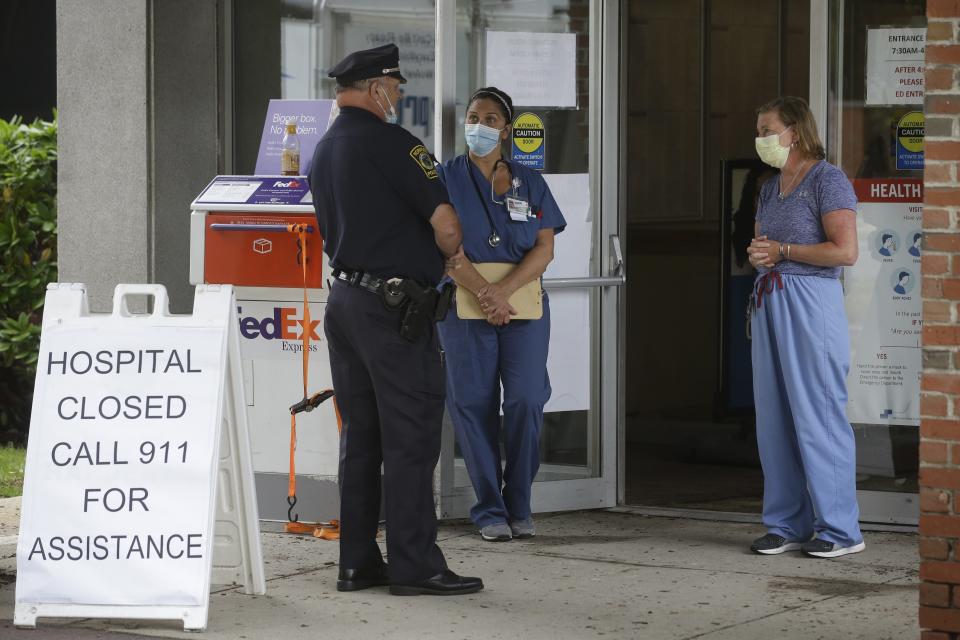Floods are a growing threat to New England hospitals – what do you do?
It was June 2020 in the thick of the COVID crisis when floodwater gushed through the doors of Norwood Hospital on a Sunday. Nearly 6 inches of rain had fallen in 90 minutes.
The flash flooding knocked out electricity at the 215-bed Massachusetts hospital. Approximately 90 patients were evacuated, starting with those in intensive care.
The hospital closed and never reopened. Demolition began this year to make way for a new facility.
If a Category 2 hurricane makes landfall in New England, approximately 15 coastal hospitals could be flooded and the access roads around them imperiled, according to a new first-of-its-kind study released this week.
Published Thursday by researchers at the Center for Climate, Health and the Global Environment at Harvard T.H. Chan School of Public Health, Boston University School of Medicine Department of Family Medicine, and PSE Healthy Energy, the study is the first to systematically investigate flood risk for nearly 700 hospitals on the Atlantic and Gulf coasts from Category 1-4 storms as climate change worsens and sea levels rise.

The Boston-Cambridge-Newton, MA-NH metro area is the third-most at risk in terms of metro areas where a Category 2 hurricane threatens access to hospital care most, and where sea-level rise this century could increase the number of hospital beds at risk of flooding by 90%, according to the study.
The findings aren't absolute, said lead author Dr. Aaron Bernstein, interim director of Harvard C-CHANGE and pediatrician at Boston Children's Hospital, but rather, "they are intended to give people a better sense of where risks are greatest, and therefore how to think a little differently about how health care (can be) as accessible as possible in the event of a disaster."
Climate change: More hurricanes could hit New York, Boston and other northern cities as planet warms
It's easy to see how patients would feel powerless in a disaster situation. But Bernstein said people should be empowered to put care plans in place with their provider, and to think through scenarios. If you have a chronic medical problem or depend on particular medical equipment, have those conversations before a flood or power outage emergency hits, he said.
"This is a sad but real wakeup call that we need to prepare for times when hospitals may not be fully capable of taking care of the entire population that needs them," said Dr. Alexandra Tarabochia-Gast, a family medicine practitioner formerly at Boston Medical Center who co-authored the study.
Hurricanes, flooding matters of public health
Hurricanes and flooding are matters of public health when, in this case, they interrupt health care delivery and access. And while historically just nine hurricanes have made landfall along the southern New England coast, the study found that even relatively weak storms pose a serious flood risk to hospitals along the coast.

The study doesn't account for rainfall, noted Bernstein, either as a result of hurricanes that hit down South or the more frequent extreme weather events the region is seeing.
Just last month, floodwater surrounded Women and Infants Hospital in Providence, Rhode Island when the state experienced torrential rain.
'Rubble floating all over the place': Fiona sweeps away homes, knocks off power in eastern Canada
Scientists have said hurricane paths are increasingly headed northward as the climate warms, demonstrated last year by Tropical Storm Henri and remnants of Hurricane Ida, and more recently by Hurricane Fiona's impact on eastern Canada.
These New England hospitals could be flooded by a Category 2 hurricane
Modeling shows 15% of hospitals and 24% of beds in the Boston-Cambridge-Newton, MA-NH metro area could be at risk, coming in third behind the Miami-Fort Lauderdale-West Palm Beach, FL and New York-Newark-Jersey City, NY-NJ-PA metro areas, according to the study published in the AGU journal GeoHealth.
Bernstein said the paper is not "agnostic to health care practice," in that it takes a nuanced look at the actual number of beds potentially impacted by flooding in proportion to the population served by those beds.

"We wanted to put this in the context of reality," he said. "Our community here around Boston was the third riskiest for loss of access to hospital care from a Category 2 storm."
Across New England, the following hospitals could face flooding as a result of a Category 2 hurricane, per the study:
Massachusetts
Cambridge Health Alliance - Cambridge campus
Cape Cod Hospital, Barnstable
Good Samaritan Medical Center, Brockton
Martha's Vineyard Hospital
Massachusetts General Hospital
Mount Auburn Hospital
Southcoast Hospital Group - Tobey Hospital campus in Wareham
Tufts Medical Center

Rhode Island
Rhode Island Hospital, Providence
South County Health, South Kingstown

Maine
Blue Hill Memorial Hospital
Eastern Maine Medical Center, Bangor
LincolnHealth - Miles campus in Damariscotta
Mercy Hospital, Portland
Midcoast Hospital, Brunswick
The study found hospitals in Connecticut aren't impacted until a Category 3 or 4 hurricane (Milford Hospital). No hospitals were found to be at risk in New Hampshire, and Vermont was not included, though the Vermont State Hospital in Waterbury was deemed unusable after Tropical Storm Irene in 2011. A new psychiatric hospital was constructed in its place.
Destruction caused by hurricanes: VT mental health system rebuilt after Hurricane Irene
Lessons from the South: How other hospitals have prepared for hurricanes, flooding
Because hurricanes impact the region less frequently, Bernstein and Tarabochia-Gast noted the Northeast's health care systems aren't likely as prepared for their impacts.
"These hospitals haven't had the past experiences like hospitals in Florida, which are preparing for Hurricane Ian right now," said Tarabochia-Gast.

Many hospitals have storm protocols in place — plans that will require reexamining as climate change causes more frequent bouts of extreme weather.
In 2019, Cape Cod Hospital published details on the actions it takes in advance of a major storm. The hospital tops off diesel tanks in its three generators and anything outdoors that might be blown away is taken down or secured. Frank Riccio, director of security, safety and emergency preparedness, said the hospital does everything it can to maintain important services, such as radiation therapy for cancer patients or long-scheduled operations.
Late September hurricane: Hurricane Ian makes landfall on Florida's southwest coast as major Category 4 storm
Cape Cod Hospital patients who can be safely discharged will be sent home, and elective surgeries will be postponed.
As Norwood Hospital begins construction on its new facility, planners have said there will be redundant stormwater mitigation systems put in place, two natural gas connections with National Grid, above-ground tanks to supply oxygen and two emergency generators. The amount of surrounding impervious surfaces will also be reduced, in order to lessen stormwater flow.

But planning has to go beyond protecting hospitals themselves, Bernstein said. In Texas, he said, the state has a system set up with the specific intent of "triaging where patients can go when a hurricane is about to make landfall."
"There's a tremendous amount of need to focus on doing patient transfers safely," he said. "Arguably we do a better job of tracking packages than people during disasters. When a human being is transferred and especially under emergency circumstances, we don't have any standardized information flow."
The study looks south for lessons learned, specifically the Southeast Louisiana Veterans Health Care Center built in 2016 that replaced the VA Hospital and Charity Hospital in New Orleans after Hurricane Katrina.
Special project: The climate future is now. Humans navigate a ‘Perilous Course’ on the East Coast.
The hospital provides "a model for how coastal hospitals and health systems can improve their resilience to hurricanes," according to the study. It was designed to remain operational for seven days even if city utilities and infrastructure are compromised and features back-up fuel supplies, on-site sewage treatment facilities, and sufficient accommodations for up to 1,000 staff and patients to shelter in place.
Critical mechanical and electrical equipment — as well as patient care areas — are located at least 20 feet above the 100-year floodplain.
This article originally appeared on USA TODAY NETWORK: New study evaluates hurricane, flooding risks to coastal hospitals

